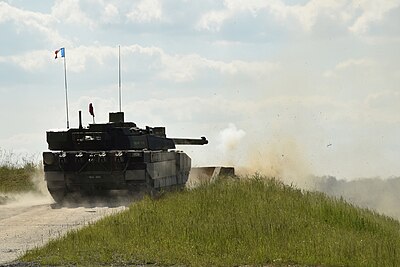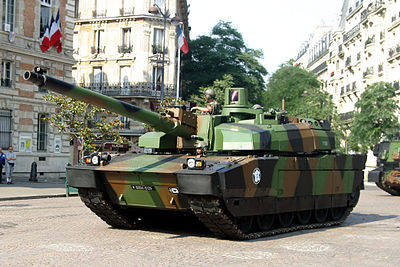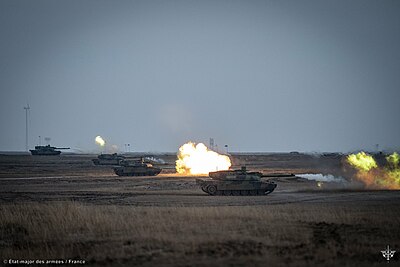Madiodha tank
| Timberwolf (Madiodha) Series MBT | |
|---|---|
 Type 2016 performing maneuver drills. | |
| Type | Main battle tank |
| Place of origin | Faneria |
| Service history | |
| In service | 2004–present |
| Wars | Peninsular War, Final War of the Deluge |
| Production history | |
| Designed | 1993-2024 |
| Unit cost | 7.89 million Taler/unit avg. |
| Produced | 2001-present |
| No. built |
|
| Variants |
|
| Specifications | |
| Mass | 56.2 tons |
| Length | 30.4 ft (22.6 without gun) |
| Width | 12.1 ft |
| Height | 8.26 ft |
| Crew | 3 (Commander, gunner, driver) |
| Armor |
|
Main armament | 4.75" Rifled Cannon (37 rounds, one chambered, 20 rounds in auto-loader, 16 rounds in hull storage) |
Secondary armament |
|
| Engine |
|
| Power/weight | 29.36 hp/t |
| Suspension | hydropneumatic |
| Fuel capacity | 1250 litres (1500 with fuel drums) |
Operational range | 340 miles (X km) without external fuel |
| Maximum speed | 50 mph on road, 45 mph open offroad |
The Type 2001 Madiodha Armachd de Charath (Aen. Timberwolf Battle Tank) is a third-generation main battle tank constructed by the National Armor Plant of Faneria and primarily fielded by the National Army of Faneria. It also serves in the armies of the Cape, Hendalarsk, Caracua, and Pelaxia. The design is unusual among modern MBTs in that its construction incorporates lighter, expensive titanium armor instead of steel in its composite. The Timberwolf is generally regarded as a high-crew survivability platform, with excellent speed and off-road rigor, as well as relative ease-of-maintenance for a modern main battle tank. It allows for a number of upgrades and deluxe munitions to improve its survivability and optical characteristics to the extreme; with a full suite of upgrades, the modernized Madiodha is one of the best-performing tanks in the world.
Design
The vehicle features a similar (although slightly smaller) hull configuration as its predecessor, the Mactliat, with a wide range of significant technical enhancements. While the original model of the series was competitive at its time of introduction, later versions of the Madiodha have pulled into the front pack of world tank designs with highly sophisticated, redundant optical and defensive measures and the existing excellent mobility characteristics on and off-road of the original. The primary drawback of the vehicle is its cost of production, being the most expensive of the third-generation tank programs. In most cases, the designing principles for the vehicle followed 'best effect' over 'best cost' due to the essentially blank check provided for the program.
Armament and Optics
The Timberwolf features a 4.75" (120.67mm) rifled gun with an advanced stabilizer and optics systems, autoloader, and coaxial munitions launcher, as well as an optional pintle mount for a machine gun operated by the commander. The primary cannon is capable of firing Fin-stabilized High Velocity Armor Piercing rounds cased in a free-spinning jacket, anti-personnel and anti-structure plastic explosive HE rounds, and simpler APDS rounds along with several specialty rounds such as the Starshell. Fin-stabilized rounds may be wholly tungsten alloy-cored or tungsten alloy with a depleted uranium tip, which provide improved armor penetration at short to medium and long range respectively due to the high muzzle velocity of the gun.

The choice to equip the tank with a rifled gun was controversial, as it required more expensive disposable jackets for HVAP munitions which are the most commonly supplied. The reasoning for the selection of a rifled barrel primarily laid in the belief that a breakdown of supply chains or a post-nuclear war scenario could require a simplification or localization of manufacture. In addition, the potential of firing near population centers was a significant ethics concern given the recent experiences of the Vandarch Canal Crisis, and a high priority had been placed on a 'one shot, one hit' policy for the military following the conflict.
The coaxial launcher fires several types of rounds, including a fragmentation grenade, colored smoke, and flares, and is loaded by the commander.
The autoloader on board is capable of loading and extraction of rounds, and has a toggle for ejecting cased rounds through a port between the driver and gunner hatches, as well as a pause toggle for manual loading of single rounds of a different type. Unlike carousel autoloaders, the system onboard the Timberwolf holds twenty rounds in a conveyor magazine, after which it must be reloaded; it is capable of extracting a casing, ejecting, and reloading in eight seconds with a cased round at high angle or five and a half seconds with a fin-stabilized round and the ejection cycle switched off and no barrel reset. Rounds are loaded at level, requiring a barrel reset during depressed or elevated fire but minimizing movement time during horizontal firing; casing ejection is designed to clear the rear of the vehicle and is potentially dangerous to people. The commander may remotely fire the cannon in the event the gunner is incapacitated, but cannot readily access the manual load port or the hull ammunition stowage, while the gunner may fire through the FCS or manually.
The Madiodha has two primary imaging suites in panoramic periscope and turret-mounted sights, with unassisted, thermal, and infrared video channels in both as well as direct observation through the commander's sight and a rangefinding laser on the coaxial suite. Notably, the commander's periscope allows for turret-down observation for concealed monitoring of a surrounding area and target tracking and ranging prior to engagements. Both imaging systems feature 2x, 6x, and 12x magnification through video and can be accessed by any of the crew, with computer-assisted highlight and track capability. Later variants also include automatic range estimation by the FCS computer through triangulation with the coaxial cameras as a stealth or backup measure. If the entire coaxial suite is disabled, the computer may be switched to stadiametric rangefinding estimation, which is less accurate particularly when engaging moving targets. The vehicle also mounts a manual sight on the hull for the driver, with later versions including a thermal channel camera for use while the primary suites are not covering the direction of travel.
The various optics and backups of the Timberwolf allow for effective operation during day or night, with the option of a 'low-emission' reduced observability mode accessible by turning off several features including the laser rangefinder and active-light IR camera.
Protection
The Madiohha carries layered defenses including up to four layers of computer-driven and armor-based protection, including APS, multiple types of PPS, partial ERA coverage, and composite titanium armor. In combination with a high speed, this makes the tank highly survivable in a fast-paced combat environment and provides an exceptional rate of crew survivability during partial vehicle kills, which favors the use of well-trained crew to maximize both the combat and survivability advantages of the system.
Passive defense for the later variants is provided by integrated ERA blocks on key areas of the hull and turret, namely the front of the hull and the front and sides of the turret. Additionally, the vehicle may deploy infrared-opaque smoke to protect itself from laser- and visually-guided ATGMs through fourteen cannisters mounted on the turret in all directions or manually in a precautionary manner through the coaxial launcher to preserve the rapid-deploy systems. Sensor, Dazzler, and Active Protection System packages for laser painter alerts and automatic soft and hard-kill defense against incoming ATGMs, mortars, rocket launcher, RPG, and recoilless rifle rounds are available. The APS system used on some Madiodhas, Wavecrest, can be manually targeted in an anti-infantry or anti-drone role as well, though these uses are actively discouraged.
The autoloader for the primary gun is separated from the crew compartment in an armored bustle and includes blowout panels which prevents catastrophic cook-off kills of the vehicle; the hull stowage is similarly equipped with blowout panels beneath the tank. In rare cases, a rapid cook-off of the lower compartment may flip the tank on its side or cause a rollover on uneven terrain, though no cases have been observed yet due to the LU-adjacent manufacturing standards of the ammunition used. During production, the lower blowout panels were derided as being mine-vulnerable despite identical armor thickness to the rest of the bottom of the hull, the additional armor between the stowage and crew compartments, and similar panels existing on the Urcean SAV-12.

The tank is capable of limited operation without its computer systems in the case of a loss of power, most notably reducing the rate of fire and incurring a loss of all ancillary metrics and target track/assist, video optics, APS, and most night-fighting capabilities. Advancements in computer design in subsequent decades have largely discredited the idea of tactical EMP weaponry, though like most modern tanks the Timberwolf is hardened with surge protection and hull grounding regardless.
Propulsion
Madrat Motor Design produces the turbine engine and ventilation system of the tank, with an MVPX-160/00 or /11 engine powering the tracks and primary systems and charging the onboard battery. The engine provides on averages 1650 horsepower with standard Fanerian ground fuel and is winterized as standard, providing excellent top speeds in forward and reverse on roads and over low and rough ground. While not as versatile as the engine of the SAV-12, the engine of the Madiodha is capable of using any grade of jet fuel or consumer-grade petrol or diesel with slightly better efficiency, with the 160/11 engine providing better ergonomics for servicing. The listed top speeds are 50/45 miles per hour on and offroad forwards and 48/40 miles per hour in reverse on and off-road, but operators claim it to be capable of up to seventy miles an hour over flat, unobstructed terrain with an unloaded hull stowage and high-end fuel. The suspension system is hydropneumatic, which is common on modern armor and allows for adjustable height, with joint or independent raising or lowering of each side of the tank.
Variants

There have been several upgrade packages since the Timberwolf's introduction to keep its technological edge in light of modern wartime experiences. After additional development, the Type 2016 variant of the Madiodha was introduced, adding an air conditioner and heater for the crew compartment in exchange for four rounds of the original 20-round hull ammunition stowage. Several design edits to the hull including more open internal compartmentalization and a revision of the blowout panels to reduce the chance of crew injury during a cookoff were made, and the Type 2016 was launched into full production to replace the shorter run of Type 2001s.
The design of the Type 2016 variation was the subject of heated debate, as it originally featured a license of an advanced Caphirian active protection system, which violates the traditional ban on foreign electronics in Fhainnin weapons systems. The Type 2016s APS also suffered from programming issues when interfaced with the Madiodha, leading to many crews removing it to prevent misfires and leaving the Type 2016 mainly distinguished externally by its additional reactive armor blocks.
The Type 2024 introduced an entirely native-manufacture APS called Wavecrest as well as an updated version of the passive countermeasures, spall lining, and the extension of reactive plating to the track skirts as an optional upgrade. Additionally, a package for launching mine detonation cord or the X light drone was developed. Both the 2016 and 2024 received command variants, while the 2016 additionally has an engineering variant with a dozer blade, crane, and expanded MVPX-180/19 engine for towing and recovery. An artillery variant to replace the X, based off the Mactliat hull, was cancelled in 2028 in favor of development of a different hullform on the same tracks and suspension to maintain some interchangeability.
Suppliers
The parts for the Madiodha are manufactured entirely within Faneria, with the major companies involved being:
- Teilgcheárta de Armachd (TANF) (Fhainnin National Armor Plant): Produces the ceramic armor components and conducts final assembles and tests of the platforms.
- Werthwr Stàilinobaer: Produces the titanium armor plates and frame.
- Madrat Motor Design: Produces the engine and ventilation system.
- Ginearált Lionsag (General Lensing): Produces the optics and other parts.
- Luthair National Munitions: Produces parts of the countermeasures systems and the secondary munitions launcher plus ammunition, as well as other components in conjunction with General Lensing.
- Faena Chemical-Electric: Produces parts of the chemical rounds and smoke cannisters and winterization supplies, as well as part of the ceramic plate layers.
- Ginearált Dealbhadh Coimpiutair (General Computer Design): Produces the onboard computers, parts of the auto-loader, the advanced system upgrades present in the 2016-3 model, and numerous minor electronics.
- Teilgcheárta de Làmhachas (TLNF) (Fhainnin National Heavy Arms Foundry): Produces the main gun and ammunition.
Performance

The Timberwolf is designed for use in a variety of terrain including rocky, moderately muddy, and heavily snowed terrain, with built-in climate control in the modern models as well as good reverse and off-road top speeds. It excels in hit-and-run and ambush scenarios particularly, though it is also perfectly capable of more extended running battles, and requires a high degree of crew training to properly manage its layered optical systems and numerous unique design choices. Importantly, the commander takes on a large number of duties, and management of the optics systems is often handled primarily by the gunner. The optics system feeds underwent several iterations to improve clarity and reduce channel and view confusion, particularly for the driver, and many of the toggles for the FCS, autoloader, and add-on packages have manual control capability that is deliberately not allowed to be used in regular operation. Additionally, the triangulation program used as a stealth option and intermediate stage between stadiametric and laser rangefinding required the periscope be kept within five degrees of the turret's target angle for continuous correction based on movement. Prior to the retirement of conscription for the National Army, conscripts never operated in armor squadrons outside of maintenance roles; Pelaxian operators of the Timberwolf compared it to 'flying a jet' rather than piloting a tank during trials, but spoke highly of its performance regardless.

Generally speaking, the tank is designed with easy winterization in mind (the engine is prepared on shipment as such already), making maintenance in good weather conditions easy to manage next to many competing tanks. The computer and prestige electronics systems require more intensive work when damaged but are broadly robust in most conditions, with the exception of the original Caphirian APS and a cancelled DICM module.
During the Final War of the Deluge, the initial deployed force of twenty Timberwolf tanks obliterated one hundred twenty-seven Algoquonan tanks for no losses during the first year of the conflict; afterwards, Fanerian and Algoquonan armor rarely engaged, with the four lost and twenty damaged models Faneria suffered in Cusinaut resulting mostly from infantry-carried weapons; in total, one tank was lost irrecoverably to enemy armor in a three-on-one close engagement, three were lost to ATGMs. Later deployment to Varshan was considerably more costly, with a total of thirty-eight Madiodhas irrecoverably damaged. A total of thirty crew were killed as a result of these losses, nineteen of which occurred during or after dismount and one of which was the commander of an otherwise operational vehicle. Of the thirty-eight lost tanks, fifteen were destroyed after dismount by friendly forces or Varshani engineers; one was lost in a blue-on-blue incident with the DAF to an airstrike and one was disabled and flooded after submerging beyond the safe unbuttoned water level while crossing wetland. Of the 21 tanks destroyed in combat outright, two were attributed to enemy airstrikes, twelve were destroyed by Varshani armor, and seven were destroyed by infantry with radar-guided ATGMs, which are the least likely type to be defeated by the Madiodha's passive defense options; eight of the tanks hit by other main battle tanks and three of the infantry-disabled vehicles were capable of return for write-off due to extensive turret damage with two or all three crew alive. The wartime experience of Fanerian armor crews in Varshan reinforced a 'death-before-dismount' culture in the wider armor corps and informed a subsequent expansion of the APS package program.
Post-invasion, the Mactliat saw considerable combat against remnant Zurgite and warlord forces as part of Faneria's League of Nations security commitments to the region. This included several major engagements such as the Battle of Aheu'lioga, where a squadron of Fanerian armor supported by RIA infantry and air elements ambushed and destroyed a convoy of several hundred well-supplied remnant troops attempting to smuggle armor and infantry vehicles to defensive holdouts in the hinterlands.
Foreign Use
Hendalarsk
In 2018, a total of 34 Type 2001s were sold to Hendalarsk at a heavy discount of 3 million Taler/unit, for a total of 102 million Talers. In 2024, one of the Hendalarskan units was briefly returned to Faneria for intensive maintenance following a failed truck-loading. Hendalarsk began local production of the jackets necessary for firing fin-stabilized munitions with the rifled gun in 2022.
Caracua
Four Type 2001s were gifted to Caracua in 2020, along with two Type 2016s in 2022; the Caracuan government purchased sixteen more Type 2016s to complete its armored element in 2033, retaining the 2001s as parts and replacement options.
Pelaxia
In 2027, the Madiodha 2016 and 2024 were nominated for the selection phase of an international tank purchase by Pelaxia. After passing, the government of Pelaxia ordered 40 Type 2024 Madiodha tanks with a cannon chambered for the new Pelaxian 120mm smoothbore standard, retaining an option for another 400 units.
the Cape
?